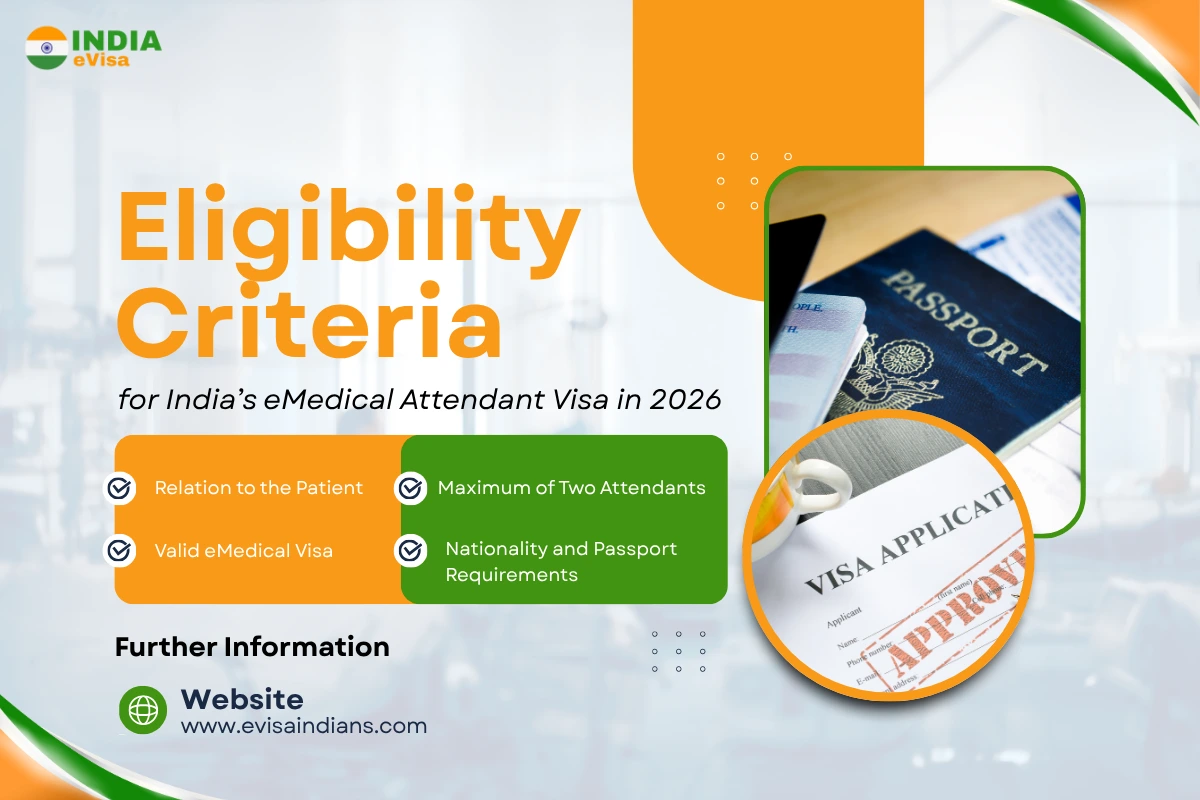Eligibility Criteria for India’s eMedical Attendant Visa in 2026

Going to another country for medical treatment is stressful. Families want one person close to the patient — someone to help with hospital visits, medicines, and comfort. India’s eMedical Attendant Visa lets a close family member or a trusted helper travel to India to stay with a patient who is getting medical care. In this simple, friendly guide I will explain who can apply, what documents you need, how to apply, what to expect at the airport, and common mistakes to avoid. Read this fully and you should have no doubts about the eMedical Attendant Visa process.
What is the eMedical Attendant Visa?
The eMedical Attendant Visa is an electronic visa category made for people who will accompany someone coming to India for medical treatment. It is not the same as a regular medical visa — it is only for the attendant, not the patient. The attendant’s visa is normally issued when the patient already has a medical visa or confirmed hospital appointment. For official rules and the online application, use the government e-visa portal.
Who can apply?
To be eligible for the eMedical Attendant Visa:
- You must be traveling specifically to accompany a patient who has a valid medical visa or confirmed treatment in India.
- Usually up to two attendants may be allowed per patient, but the exact number can depend on nationality and the hospital’s request.
- Attendants are normally close family members (spouse, parent, child, sibling) or a designated caregiver named by the hospital. If you are not a family member, a hospital letter naming you as the attendant helps a lot.
Documents you must prepare
Clear, correct documents are the heart of a successful application. Typical documents for the eMedical Attendant Visa include:
- Passport bio page (valid for at least six months from date of arrival and with at least two blank pages).
- Recent passport-size photograph in the required format.
- A hospital letter on official letterhead confirming the patient’s admission or appointment and naming the attendant. Many hospitals must register on the medical portal before issuing this letter.
- Proof of relationship with the patient (birth or marriage certificate) if you are a family member, or an affidavit if required.
- Return or onward travel ticket and proof you can support yourself during the stay.
- If you are a health professional acting as an attendant, sometimes your medical credentials help.
Always upload clear scans. Blurry or partial images are a common reason for delay or rejection.
How and when to apply
You must apply online through the official e-Visa portal. For the eMedical Attendant Visa, the portal usually allows applications from 120 days up to 4 days before arrival. After you apply and pay the fee, you will receive an Electronic Travel Authorization (ETA) by email. Print the ETA and carry it with your passport when you travel. Before you fly, check your India Visa Status online to make sure your ETA is “GRANTED.”
Tip: Keep a digital copy of the ETA and the hospital letter on your phone and a printed copy in your hand luggage.
Validity and registration rules
The attendant visa’s validity usually matches the patient’s medical visa and the treatment period. If your combined stay in India goes beyond 180 days, you must register with the nearest Foreigners Registration Office (FRO) within 14 days of arrival. If your approved stay is 180 days or less, registration may not be required. This rule helps avoid fines or legal issues, so set a reminder if your stay might become long.
What happens at arrival
On arrival, immigration officers will check your passport and ETA for the eMedical Attendant Visa. They may take fingerprints and a photo. Keep the hospital letter, the patient’s medical visa, and proof of onward travel handy for inspection. If you plan to travel between cities for care, carry photocopies of your main documents. If anything changes (like the hospital or dates), inform the hospital and the visa office quickly.
Common reasons for rejection — and how to avoid them
People often get refused for simple reasons. Avoid these mistakes:
- Weak hospital letter — make sure it lists the patient, the attendant, and treatment dates. Hospitals often need to pre-validate the letter.
- Passport problems — less than six months validity or not enough blank pages.
- Applying too late — leave enough time for processing and fixes.
- Wrong visa category — don’t apply for tourist visa if you need a medical attendant visa.
- Poor scans — upload clean, full images.
Fix these before you submit: ask the hospital to prepare a correct letter, check passport dates, and have all documents ready in good quality.
A few human tips
- Talk to the hospital’s international patient desk — they often help with visa letters and airport pick-up.
- Save emergency numbers (hospital, your embassy) on your phone.
- Make a simple checklist for medicines, appointment dates, and consent forms — small lists cut a lot of stress.
If you need the exact online steps, visit the official India Visa Online e-visa portal and track your India Visa Status there to make sure everything is on track.
Final words
The eMedical Attendant Visa helps families stay together during medical treatment in India. With the right documents, an accurate hospital letter, and an early online application, the process is usually smooth. Read this guide, follow the checklist, and check your India Visa Status before travel — and you’ll be ready to focus on what really matters: the patient’s care and comfort. If you want, I can make a printable checklist or a sample hospital letter you can give to the hospital.
